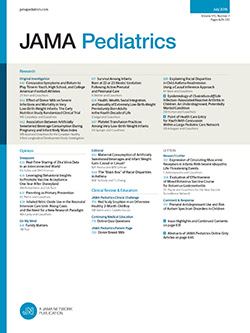Tacrolimus or Mycophenolate Mofetil for Frequently Relapsing or Steroid-Dependent Nephrotic Syndrome: A Randomized Clinical Trial.
IF 24.7
1区 医学
Q1 PEDIATRICS
引用次数: 0
Abstract
Importance Both tacrolimus (TAC) and mycophenolate mofetil (MMF) are recommended for children with frequently relapsing nephrotic syndrome (FRNS) or steroid-dependent nephrotic syndrome (SDNS). However, their comparative effectiveness and safety have not been evaluated through randomized clinical trials. Objective To compare the effectiveness and safety of TAC and MMF in children with FRNS or SDNS. Design, Setting, and Participants In this multicenter, open-label randomized clinical trial conducted at 12 pediatric nephrology centers across China, 270 children aged 2 to 18 years with FRNS or SDNS were allocated at a 1:1 ratio to treatment with either TAC or MMF. The study was conducted from November 2019 to July 2023, and data analysis was completed from July 2023 to March 2024. Intervention Patients received either TAC (0.025-0.050 mg/kg, orally twice daily) or MMF (10-15 mg/kg, orally twice daily) for 1 year, along with a tapering regimen of steroids. Main Outcomes and Measures The primary end point was 1-year relapse-free survival. Relapse frequency, cumulative steroid dosage, and safety profiles were also evaluated. Results A total of 292 patients from 12 care centers were assessed for eligibility, and 270 patients were randomized to receive either TAC (n = 135) or MMF (n = 135). Among 270 patients, median (IQR) age was 6.91 (4.25-9.96) years, and 70 patients (25.9%) were female. Compared with MMF, the 1-year relapse-free survival rate in the TAC group was 1.86-fold higher (hazard ratio [HR], 2.86; 95% CI, 1.79-4.76; P < .001) in the intention-to-treat analysis. This difference was also significant after adjusting for the per-protocol analysis (HR, 2.78; 95% CI, 1.72-4.55; P < .001). The mean (SD) time to first relapse was significantly longer in the TAC group (323.99 [98.33] days) compared to the MMF group (263.21 [132.84] days). Furthermore, the TAC group showed a lower annual relapse rate than the MMF group (17.78% vs 41.48%) and required a significantly lower mean (SD) cumulative steroid dose (0.22 [0.10] mg/kg/day vs 0.34 [0.22] mg/kg/day). The safety profile was similar in both groups. Conclusions and Relevance In this randomized clinical trial, compared with MMF, a 1-year course of TAC therapy significantly extended the period of relapse-free survival in children with FRNS or SDNS. Trial Registration ClinicalTrials.gov Identifier: NCT04048161.他克莫司或霉酚酸酯治疗频繁复发或类固醇依赖性肾病综合征:一项随机临床试验
他克莫司(TAC)和霉酚酸酯(MMF)均被推荐用于患有频繁复发性肾病综合征(FRNS)或类固醇依赖性肾病综合征(SDNS)的儿童。然而,它们的相对有效性和安全性尚未通过随机临床试验进行评估。目的比较TAC与MMF治疗FRNS或SDNS患儿的有效性和安全性。设计、环境和参与者:在中国12个儿科肾病中心进行的这项多中心、开放标签随机临床试验中,270名年龄在2至18岁的FRNS或SDNS患儿按1:1的比例被分配到TAC或MMF治疗组。研究时间为2019年11月至2023年7月,数据分析时间为2023年7月至2024年3月。干预:患者接受TAC (0.025-0.050 mg/kg,每日口服两次)或MMF (10-15 mg/kg,每日口服两次)治疗1年,同时逐渐减少类固醇治疗方案。主要终点为1年无复发生存期。复发率,累积类固醇剂量和安全性也进行了评估。结果共对来自12个护理中心的292例患者进行了资格评估,其中270例患者随机分为TAC组(n = 135)和MMF组(n = 135)。270例患者中位(IQR)年龄为6.91(4.25 ~ 9.96)岁,女性70例(25.9%)。与MMF相比,TAC组1年无复发生存率高1.86倍(风险比[HR], 2.86;95% ci, 1.79-4.76;P < 0.001)。在对每个方案分析进行调整后,这种差异也很显著(HR, 2.78;95% ci, 1.72-4.55;p < 0.001)。与MMF组(263.21[132.84]天)相比,TAC组(323.99[98.33]天)至首次复发的平均(SD)时间明显更长。此外,TAC组的年复发率低于MMF组(17.78% vs 41.48%),所需的平均(SD)累积类固醇剂量显著降低(0.22 [0.10]mg/kg/day vs 0.34 [0.22] mg/kg/day)。两组的安全性相似。结论和相关性在这项随机临床试验中,与MMF相比,1年的TAC治疗显著延长了FRNS或SDNS患儿的无复发生存期。临床试验注册号:NCT04048161。
本文章由计算机程序翻译,如有差异,请以英文原文为准。
求助全文
约1分钟内获得全文
求助全文
来源期刊

JAMA Pediatrics
PEDIATRICS-
CiteScore
31.60
自引率
1.90%
发文量
357
期刊介绍:
JAMA Pediatrics, the oldest continuously published pediatric journal in the US since 1911, is an international peer-reviewed publication and a part of the JAMA Network. Published weekly online and in 12 issues annually, it garners over 8.4 million article views and downloads yearly. All research articles become freely accessible online after 12 months without any author fees, and through the WHO's HINARI program, the online version is accessible to institutions in developing countries.
With a focus on advancing the health of infants, children, and adolescents, JAMA Pediatrics serves as a platform for discussing crucial issues and policies in child and adolescent health care. Leveraging the latest technology, it ensures timely access to information for its readers worldwide.
 求助内容:
求助内容: 应助结果提醒方式:
应助结果提醒方式:


